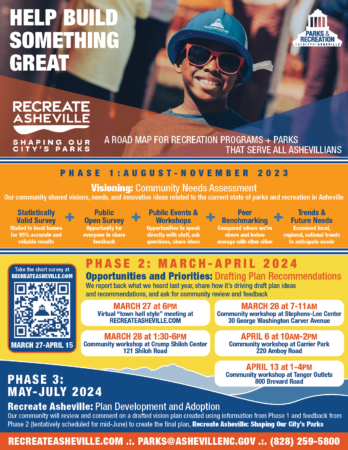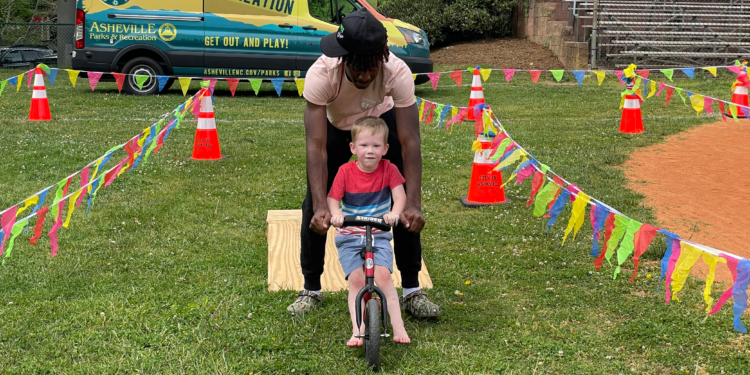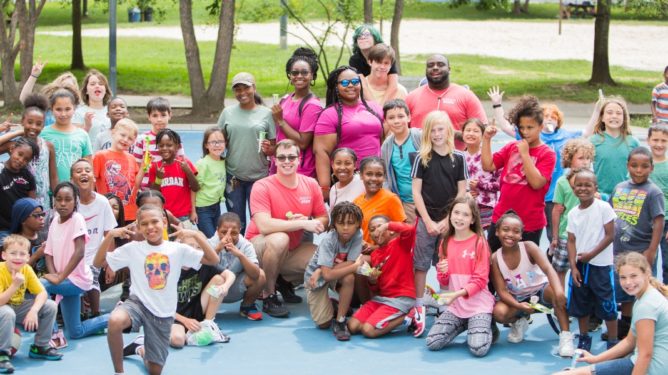Help unlock the power of our community by building Recreate Asheville: Shaping Our City’s Parks, a road map to guide recreation programs, sports and leisure spaces, and parks for future generations. This is an important opportunity for Ashevillians to create a long-term vision and help inform how projects are prioritized to meet the modern needs of our city – from major improvements to existing parks (beyond just maintenance and repairs) to strategies that use recreation programs to build stronger neighborhoods.
REVIEW RECREATE ASHEVILLE DRAFT PLAN
Where are Asheville’s public parks, greenways, and community centers? Use APR Finder to search based on locations and features.
Happening Now
Our community will review and comment (scheduled for June) on a drafted vision plan created using information from Phase 1 and feedback from Phase 2 to create the final plan, Recreate Asheville: Shaping Our City’s Parks.
- For those unfamiliar with some of the terms, we’ve provided answers to Frequently Asked Questions below.
- Click the flyer for a detailed look at the timeline in English and en español.
What You Can Do Now:
- Read the draft plan
- View a presentation to the City of Asheville’s Environment and Safety Committee summarizing the draft plan here or view slides here
What’s Happened So Far?
During Phase 1: Community Needs Assessment, community members shared needs, opportunities, and feedback related to the current state of parks and recreation in Asheville through:
- Statistically valid survey mailed to homes citywide for 95% accurate and reliable results
- Public open survey online and at events
- Workshops
- Focus groups
- Listening sessions
- Pop-up events
That information was combined with anticipated future needs and comparisons to similarly sized cities’ parks and recreation systems to define our community’s needs.
During Phase 2: Drafting Plan Recommendations, we reported back what we heard during Phase 1, shared how it’s driving draft plan ideas and recommendations, and asked for additional community feedback through an online survey, virtual meeting, four in-person community workshops, and neighborhood meetings between March 27-April 15. Information and community feedback from both phases are being used to draft the plan.
Frequently Asked Questions
What is a statistically valid survey?
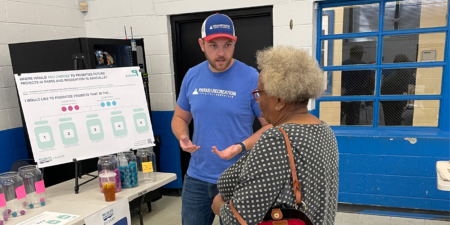 A statistically valid survey is one of a number of ways information was collected during the community needs assessment phase of building the Recreate Asheville plan. It is not possible to survey every single person living in Asheville, but it is possible to scientifically collect feedback from a representative sample to accurately estimate the larger population’s opinion within a small margin of error.
A statistically valid survey is one of a number of ways information was collected during the community needs assessment phase of building the Recreate Asheville plan. It is not possible to survey every single person living in Asheville, but it is possible to scientifically collect feedback from a representative sample to accurately estimate the larger population’s opinion within a small margin of error.
Surveys were mailed to random households representing the demographics of Asheville’s population from age, race, gender, geographic location, and persons living with a disability, among others. While only 400 were needed to reach the level of reliability within five points of a margin of error, 672 completed surveys were received. This method removes the bias of special interest groups and maintains the highest standards of reliability as outlined by the American Association for Public Opinion Researchers’ Best Practices for Survey Research.
At the same time statistically valid responses were collected, the wider community had the opportunity to share visions, needs, and innovative ideas through a public open survey and public events and workshops. There is no shortage of creativity in our community, so combining that feedback with the highly reliable research conclusions will produce the best plan to strengthen our neighborhoods using the power of public recreation programs and parks.
How can I advocate for specific programs or facilities like pickleball courts, an indoor pool, or covered roller skating rink in my neighborhood?
The Recreate Asheville plan is a community-built comprehensive plan to guide long-range planning, address service gaps, and identify opportunities for improvements across the entire Asheville Parks & Recreation system. It is a visionary document that sets the values and goals for investments for the first phase and a framework to guide future opportunities in recreation programs and spaces.
It will not contain detailed design proposals for specific neighborhoods, parks, or facilities. As a method to inform future budgets and the possible general obligation bond, providing feedback is an excellent way to advocate for systemwide courts, pools, skating rinks, and other amenities for our city.
What are the next steps in building Recreate Asheville: Shaping Our City’s Parks?
Information from Phase 1 (community needs assessment) and feedback from Phase 2 (drafting plan recommendations) will be used to draft a vision plan that our community will review and comment on to create the final plan, Recreate Asheville: Shaping Our City’s Parks. The review and comment period is tentatively scheduled for mid-June.
During Phase 1 (community needs assessment), community members shared needs, opportunities, and feedback related to the current state of parks and recreation in Asheville through surveys (including a statistically valid survey and public open survey), workshops, focus groups, listening sessions, and pop-up events. That information was combined with anticipated future needs and comparisons to similarly sized cities’ parks and recreation systems to define our community’s needs.
During Phase 2 (drafting plan recommendations), we reported back what we heard during Phase 1, shared how it’s driving draft plan ideas and recommendations, and asked for additional community feedback through an online survey, virtual meeting, four in-person community workshops, and neighborhood meetings between March 27-April 15. Information and community feedback from both phases are being used to draft the plan.
How does a general obligation bond work and how will bonds influence projects?
A general obligation bond is a long-term borrowing option that carries the lowest interest rate of all financing options available to municipalities in North Carolina and is utilized by cities and towns of all sizes, saving millions in higher borrowing costs and improving life for their residents. While CIty Council approves an annual budget to cover general maintenance, employee salaries, and short-term projects, a general obligation bond allows the City of Asheville to borrow a larger amount of money at a low interest rate to complete many projects now and pay over a period of time.
The process starts with a bond referendum, a voting process that gives voters the power to decide if the city they live in should raise funds through the sale of bonds. In 2016, Asheville voters overwhelmingly approved a $17 million bond referendum to modernize and enhance parks and community centers throughout the city, making them safer and more accessible.
Projects identified during Asheville Parks & Recreation’s previous comprehensive plan were prioritized using a scoring system that placed equity at its forefront. Bond-funded projects include the expansion and new pool at Dr. Wesley Grant Sr. Southside Community Center, new pickleball/tennis courts and the city’s first all-abilities playground in Murphy-Oakley Park, land acquisition for a new park off Sweeten Creek Road, and playground replacement at Augusta Barnett Park, to offer some examples of many improvements.
Bond-funded projects also allowed Asheville Parks & Recreation to leverage money from its annual budget over the same years to complete major investments in Weaver Park, Walton Street Park, Asheville Skatepark, Linwood Crump Shiloh Community Center, and other locations.
Can grants, public-private partnerships, and/or the Buncombe County Tourism Development Authority pay for some of these projects?
Many of Asheville Parks & Recreation’s cherished spaces were made possible by grants and public-private partnerships, and we continue to explore ways to build on this long history. As a department focused on neighborhood-level access to the highest-quality recreation programs, community centers, and parks, many of our projects are strong candidates for state and federal grants.
However, they often do not meet the criteria of the Buncombe County Tourism Development Authority’s funding grants. When they do, Asheville Parks & Recreation advocates for projects when the City of Asheville discusses applications during the TDA’s funding cycles.
The Recreate Asheville plan will be one of the strongest tools we have to apply for major grants or explore partnerships with other government agencies, community organizations, and the private sector.
How is the City of Asheville’s budget created? How are other City of Asheville projects prioritized and funded?
The City of Asheville’s annual operating and capital budget is guided by input from the community, much like the Recreate Asheville plan. For the upcoming fiscal year that runs from July 1, 2024-June 30, 2025, City Council accepted public comment for budget priorities at its January 23 meeting and through a public open survey from January 23-February 23.
The six priorities established through this process help guide City Council, City staff, and the City of Asheville’s annual operating and capital budget and annual workplans.
- Neighborhood and Climate Resilience
- Equitable, Affordable Housing and Stability
- Improve and Maintain Infrastructure and Core Services
- Reparations
- Reimagining Public Safety
- Homelessness Strategies
Key dates in the budget process can be found here.
Just as Asheville Parks & Recreation prioritizes projects by looking at all parks, community centers, programs, and facilities from a systemwide perspective, the City of Asheville looks at current and future needs from a citywide perspective.
Why are schools, pools, and libraries closing?
Just as the Recreate Asheville plan considers future growth, local and regional trends, and a number of other factors to project needs, Buncombe County government’s and Asheville City Schools’ short- and long-term projections may determine how to best provide quality services within their operating budgets.
Aging infrastructure, deferred maintenance, and changing populations are not unique to our community, but we know we live in a special place with engaged and innovative people. While recent closures may not be the last of the difficult decisions, each is made after carefully considering stability and continuity of service for the people we serve.
Background
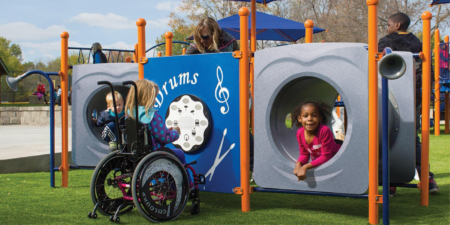 It’s impossible to imagine Asheville without public spaces like Walton Street Park, Carrier Park, Reed Creek Greenway, Linwood Crump Shiloh Community Center, and Pack Square. The city’s unique parks, greenways, and recreation complexes are where the community connects and makes memories.
It’s impossible to imagine Asheville without public spaces like Walton Street Park, Carrier Park, Reed Creek Greenway, Linwood Crump Shiloh Community Center, and Pack Square. The city’s unique parks, greenways, and recreation complexes are where the community connects and makes memories.
Help unlock the power of our community by building Recreate Asheville: Shaping Our City’s Parks, a plan to guide recreation programs, sports and leisure spaces, and parks for future generations. This is an important opportunity for Ashevillians to create a long-term vision and help inform how projects are prioritized to meet the modern needs of our city – from major improvements to existing parks (beyond just maintenance and repairs) to strategies that use recreation programs to build stronger neighborhoods.
Recreate Asheville will serve as a road map for the next 10 years to connect, fix, build, and preserve recreation programs and parkland. Building the plan takes collaboration and community input. There will be plenty of opportunities to share ideas and discuss recommendations with neighbors, so sign up for the APR monthly newsletter to stay in the know.
 What is a city park or community center?
What is a city park or community center?
Great question! Recreate Asheville provides guidance for APR, a department of the City of Asheville.
While some private parks like Beaver Lake and Botanical Gardens at Asheville allow public access, they’re not managed by APR. Ditto for state and federal lands like Thomas Wolfe Memorial or Bent Creek Experimental Forest, as well as Buncombe County parks inside city limits like Hominy Creek River Park. It also won’t cover private organizations like country clubs or YMCA centers.
Use APR Finder to explore parks, playgrounds, greenways, and open areas in the APR system.
What are Asheville Parks & Recreation’s current programs?
With multiple full-complex recreation centers, sports fields and courts, and parks throughout the city, there are hundreds of wellness, education, and culture enrichment opportunities for people of all ages every month.
Check out the current APR Program Guide and never be bored again.
Community Engagement Events
Community input drives Recreate Asheville, so we want to hear from YOU! Watch for APR team members at festivals, events, and public workshops around the city or stop by a community center to find out more about the process. The list below is not exhaustive.
2023
- September 30: Festival of Neighborhoods
- October 4: River Arts District Farmers Market
- October 5: Drop-in Community Workshop at WNC Nature Center
- October 6: Drop-in Community Workshop at Dr. Wesley Grant Sr. Southside Community Center
- October 6: East Asheville Tailgate Market
- October 7: Burton Street Ag Fair at Burton Street Community Center
- October 8: Barktoberfest at French Broad River Park
- October 9: Drop-in Community Workshop at Linwood Crump Shiloh Community Center
- October 10: West Asheville Tailgate Market
- October 12: Drop-in Community Workshop at Carrier Park
- October 14: Asheville City Market
- October 20: Social Skate Night at Carrier Park
- November 3: First Friday on The Block
2024
- March 27-April 15: Online survey
- March 27: Virtual Meeting
- March 28: Drop-in Community Workshop at Stephens-Lee Community Center
- March 28: Drop-in Community Workshop at Linwood Crump Shiloh Community Center
- April 6: Drop-in Community Workshop at Carrier Park
- April 13: Drop-in Community Workshop at Tanger Outlets
- June 20-July 7: Community draft plan review and feedback survey
Current Project Timeline
2023
- March 28: City Council unanimously adopts resolution authorizing City Manager to execute a contract with Design Workshop for development of a comprehensive parks and recreation master plan
- May-July: Design Workshop and APR collaborate on community needs assessment process
- August: Focus group meetings and stakeholder discussions
- September 26-November 20: Citywide survey and public workshops, meetings, and discussions
- December 2023-March 2024: Draft plan recommendations
2024
- March: Data from statistically valid survey mailed to homes throughout the city, online survey, in-person workshops and engagement events, focus group meetings, and stakeholder discussions share with the community for feedback
- April-May: Strategic action plan development
- June 20: Community-created Recreate Asheville: Shaping Our City’s Parks draft published
- July 23: Plan presented to Environment and Safety Committee for adoption
- August 27: Plan presented to City Council for adoption
Supporting Documents
- Resolution to Develop a Comprehensive Asheville Parks & Recreation System Master Plan
- Asheville Parks & Recreation 2015 Comprehensive Plan (1998)
- Asheville Parks, Recreation, Cultural Arts, & Greenways Comprehensive Plan (2009)
- Park Views: A Brief History of Asheville’s Public Places
Contact Information
Asheville Parks & Recreation, parks@ashevillenc.gov, 828-259-5800

